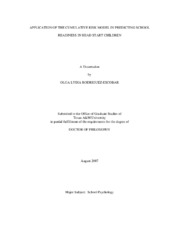| dc.contributor.advisor | Riccio, Cynthia A. | |
| dc.creator | Rodriguez-Escobar, Olga Lydia | |
| dc.date.accessioned | 2010-01-14T23:57:21Z | |
| dc.date.accessioned | 2010-01-16T02:00:00Z | |
| dc.date.available | 2010-01-14T23:57:21Z | |
| dc.date.available | 2010-01-16T02:00:00Z | |
| dc.date.created | 2007-08 | |
| dc.date.issued | 2009-05-15 | |
| dc.identifier.uri | https://hdl.handle.net/1969.1/ETD-TAMU-1623 | |
| dc.description.abstract | This study investigates the degree to which the cumulative risk index predicted school readiness in a Head Start population. In general, the reviewed studies indicated the cumulative risk model was efficacious in predicting adverse developmental outcomes. This study built on this literature by investigating how child, parent, and family risk factors predicted school readiness in Head Start children using two statistical models. Specific aims of this study included identifying 1) to what degree multiple predictors contributed to school readiness and 2) to what degree the cumulative risk index contributed to school readiness. Participants included 176 Head Start children ages 3 to 5 years. Data were analyzed using multivariate regression to determine if the cumulative risk model was a stronger predictor of school readiness than any risk factor in isolation. Hierarchical regression was also utilized to determine if individual risk factors contributed anything above and beyond the sum, the cumulative risk index. Multiple regression analysis revealed that older age and previous enrollment in Head Start predicted higher scores, while low income predicted lower scores, as did taking the test in Spanish. Analysis also revealed that higher scores on the cumulative risk index predicted lower test scores. The analysis revealed that the individual risk factors did not contribute to the model above and beyond the cumulative risk index. Adding the individual risk factors did not account for more variance than using gender, age, and the cumulative risk index as the only predictors. Similarly, the cumulative risk index did not account for more variance than using age and gender as the only predictors. The current study adds empirical support to the continued use of the cumulative risk model in predicting adverse developmental outcomes. | en |
| dc.format.medium | electronic | en |
| dc.format.mimetype | application/pdf | |
| dc.language.iso | en_US | |
| dc.subject | Cumulative Risk Model | en |
| dc.subject | Head Start | en |
| dc.title | Application of the cumulative risk model in predicting school readiness in Head Start children | en |
| dc.type | Book | en |
| dc.type | Thesis | en |
| thesis.degree.department | Educational Psychology | en |
| thesis.degree.discipline | School Psychology | en |
| thesis.degree.grantor | Texas A&M University | en |
| thesis.degree.name | Doctor of Philosophy | en |
| thesis.degree.level | Doctoral | en |
| dc.contributor.committeeMember | Ash, Michael J. | |
| dc.contributor.committeeMember | Doss, Amanda Jensen | |
| dc.contributor.committeeMember | Stanley, Christine A. | |
| dc.type.genre | Electronic Dissertation | en |
| dc.type.material | text | en |
| dc.format.digitalOrigin | born digital | en |


